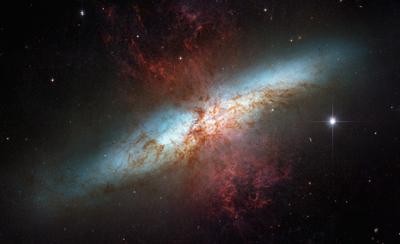







| BOOKS | F. A. Q. | ARTICLES | TALKS | ABOUT KEN | DONATE | BEYOND OUR KEN |
|---|
By Ken Croswell
Published on New Scientist (August 19, 2016)

Credit: Credit: Hubble Space Telescope. NASA, ESA, and The Hubble Heritage Team (STScI/AURA). Acknowledgment: J. Gallagher (University of Wisconsin), M. Mountain (STScI), and P. Puxley (National Science Foundation)
An exuberant galaxy is running on empty, consuming gas so fast that it may stop forming stars in just 8 million years – the blink of an eye, cosmically speaking.
M82 (pictured above) is one of the nearest “starburst” galaxies, lying just 12 million light-years away. Although much smaller than the Milky Way, each year it spawns far more stars.
Now John Chisholm of the University of Wisconsin at Madison and Satoki Matsushita of Academia Sinica in Taipei, Taiwan, have taken a hard look at our splendiferous neighbour to see whether it can keep it up.
Their conclusion: it can’t.
The astronomers used radio observations to quantify how much gas M82 acquires from its surroundings, as well as how much gas its stars blow out when they explode. In particular, they focused on the dense molecular gas from which stars form.
“Fairly surprisingly, we found that the gas that’s ejected out of the galaxy is larger than the star formation rate,” Chisholm says. “Also, the outflow rate is much, much higher than the inflow rate.”
Looking bleak
The numbers are bleak. We already knew that the glittering galaxy converts 13 solar masses of molecular gas into stars each year, and Chisholm and Matsushita now find that it’s losing another 17 solar masses via outflows. Each year it takes in a mere 3.5 solar masses of new gas.
Given the galaxy’s supply of molecular gas, at this rate M82 will probably run out in just 8 million years, say Chisholm and Matsushita.
“That’s super short,” says Adam Leroy of Ohio State University in Columbus, who says the study is the best attempt yet to quantify the spendthrift galaxy’s predicament. “I definitely buy that it is doing something unsustainable.”
Still, M82 may buy itself some time if it can convert some of its abundant atomic gas, which is not dense enough to make stars, into a molecular form.
Giant spiral galaxies like the Milky Way face a similar but less pressing problem. Astronomers estimate that most of these galaxies will run out of gas in another 1 or 2 billion years. But the Milky Way is lucky: its two brightest satellite galaxies, the Magellanic Clouds, are shedding so much gas into its halo that its star-making career will probably continue for billions of years to come.
Ken Croswell earned his Ph.D. in astronomy from Harvard University and is the author of The Alchemy of the Heavens and The Lives of Stars.
"An engaging account of the continuing discovery of our Galaxy...wonderful." --Owen Gingerich, The New York Times Book Review. See all reviews of The Alchemy of the Heavens here.
"A stellar picture of what we know or guess about those distant lights."--Kirkus. See all reviews of The Lives of Stars here.
| BOOKS | F. A. Q. | ARTICLES | TALKS | ABOUT KEN | DONATE | BEYOND OUR KEN |
|---|